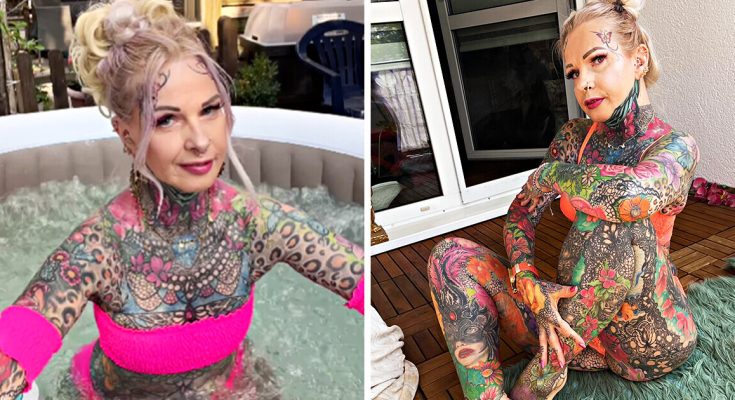A story about a grandma who has her body fully covered in tattoos could delve into themes of personal transformation, artistic expression, and the social perceptions of body art. This narrative would likely explore how her appearance evolved over the course of a decade, reflecting not only a shift in her personal style but perhaps also changes in her identity, values, and the influence of tattoo culture.

Initially, the grandma likely looked more conventional, with no visible tattoos marking her skin. Over the years, she became more immersed in the world of tattoos, finding comfort and meaning in each design she added. Tattoos can represent significant events, emotions, or milestones in a person’s life. For this grandmother, her body became a canvas, one that spoke of her journey, her passions, and her defiance of societal norms that traditionally discourage older women from embracing such bold forms of self-expression.
The transformation was probably gradual. Perhaps her first tattoo was something small and personal, a tribute to a loved one or a meaningful phrase. As the years passed, she continued to add more ink, covering her arms, back, legs, and eventually her entire body. This could have been part of a broader journey toward self-discovery, one in which she came to embrace her uniqueness and reject the stereotypes associated with age and appearance.

Throughout the process, there may have been moments of doubt or confrontation with societal judgment. Friends, family, or strangers could have questioned her decisions, asking why someone her age would want to cover their body in tattoos. The narrative could also touch on the assumptions people made about her—perhaps they saw her as rebellious, unconventional, or even a misfit. Yet, her tattoos were more than just an act of rebellion; they were a form of storytelling, a way to assert control over her body and her identity in a world that often dictates how people, especially women, should look and behave as they age.
In contrast to her current heavily tattooed appearance, the narrative would reflect on how she looked a decade ago—a time when perhaps she adhered more closely to societal expectations. Without tattoos, she might have blended in more easily, her appearance not drawing much attention. But with each tattoo, she began to stand out more, challenging perceptions of what it means to grow old.
Her story would resonate with themes of empowerment, showing how aging can be a time for personal liberation rather than constraint. For this grandmother, embracing body art in later life allowed her to redefine beauty on her terms, rejecting conventional standards and celebrating her individuality.
A significant part of the story would focus on her emotional and psychological journey throughout this transformation. It would explore how the act of getting tattooed became a meditative and cathartic experience, helping her process past experiences, grief, joy, or moments of personal growth. Each tattoo might carry a story—perhaps one is dedicated to a lost loved one, while another symbolizes her survival through difficult times.

The societal implications of her transformation could also be explored, particularly the reactions of those around her. Tattoos on older women are still relatively rare, and her bold choices could have sparked conversations about aging, femininity, and body autonomy. Some might see her as an inspiring figure, someone who defies the norms and encourages others to live authentically, while others might react with discomfort or judgment. Her journey challenges the notion that body art is only for the young, and it opens a broader conversation about the freedom to express oneself at any age.
By the end of the story, this grandma’s decision to cover her body in tattoos becomes more than just an aesthetic choice—it becomes a statement about living life fully and unapologetically. It’s a reminder that our bodies are our own to decorate, change, and celebrate however we choose, regardless of our age. The tattoos, once seen as marks of rebellion, come to represent a life lived on one’s own terms—a true testament to her courage, creativity, and resilience.
The narrative concludes by reflecting on how her appearance from a decade ago contrasts with her present self. While her skin may have changed with ink, her spirit remains strong, vibrant, and untamed. Her tattoos are a testament to the idea that it’s never too late to embrace change, express oneself, and live authentically.



